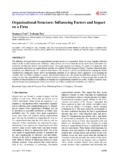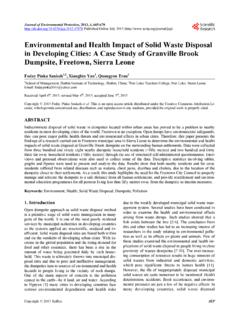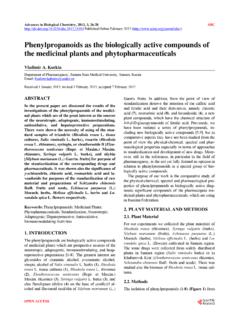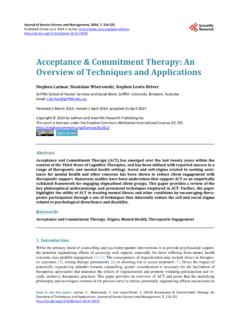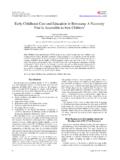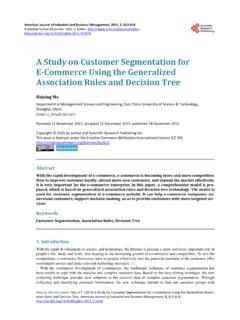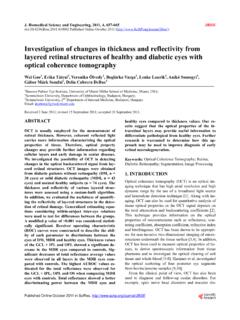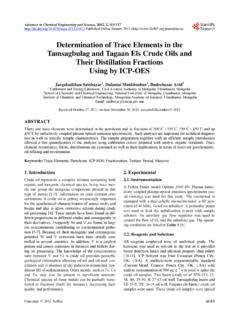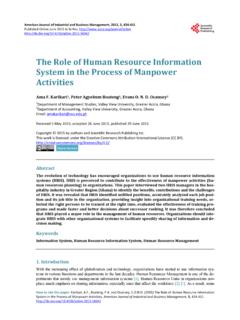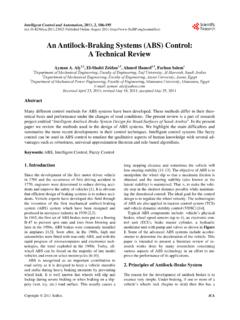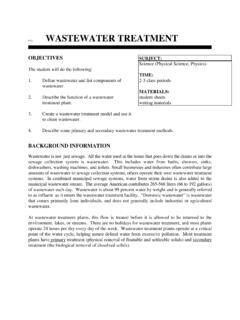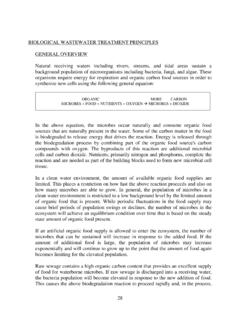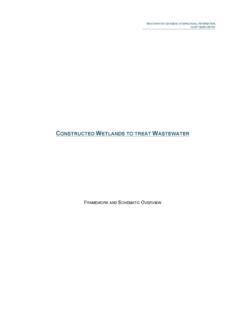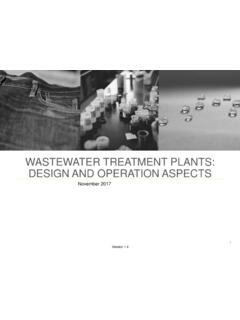Transcription of Design and Comparison of Wastewater Treatment Plant …
1 Journal of Environmental Protection, 2018, 9, 636-651. ISSN Online: 2152-2219. ISSN Print: 2152-2197. Design and Comparison of Wastewater Treatment Plant Types (Activated Sludge and Membrane Bioreactor), Using GPS-X Simulation Program: Case Study of Tikrit WWTP. (Middle Iraq). Alaa Uldeen Athil Arif*, Mohamed Tarek Sorour, Samia Ahmed Aly Sanitary Engineering Department, Faculty of Engineering, Alexandria University, Alexandria, Egypt How to cite this paper: Arif, , So- Abstract rour, and Aly, (2018) Design and Comparison of Wastewater Treatment Mathematical models and simulation are considered a powerful tool in engi- Plant Types (Activated Sludge and Mem- neering practice.)
2 Those tools are becoming increasingly used for the im- brane Bioreactor), Using GPS-X Simulation provement of Wastewater Treatment plants Design because the conceptual de- Program: Case Study of Tikrit WWTP. (Middle Iraq). Journal of Environmental sign is complex and ill-defined. In this paper, three alternatives: 1) complete Protection, 9, 636-651. mix activated sludge without nitrogen removal (CAS); 2) complete mix acti- vated sludge with nitrogen removal (CAS-N) and; 3) membrane bioreactor Received: March 12, 2018. (MBR) processes were designed into two steps: first concept Design to calcu- Accepted: May 28, 2018 late the size of process units, then second implement modeling and simulation Published: May 31, 2018 to improve the accuracy of the conceptual Design .
3 In brief, the Treatment process Design has been verified by using the activated sludge model No. 1. Copyright 2018 by authors and Scientific Research Publishing Inc. (ASM1) in GPS-X ( ) simulation software. This application helps not only This work is licensed under the Creative in sizing the Treatment units but also in understanding the Plant 's capacity. In Commons Attribution International the same time, it can assist in studying the future expansion works required License (CC BY ). for increased hydraulic and organic loadings. For this purpose, Tikrit WWTP.
4 Open Access was selected as a case study. The used model was validated by comparing the designed values of the Plant and the modeling data. The verification of the obtained results from both hand calculations and the results of the program showed a good agreement. A significant difference in the volume of secondary Treatment was obtained from Design calculations, where the CAS without de- nitrification system was 9244 m3 (aerobic and secondary tanks), CAS with de- nitrification system was 11,324 m3 (anoxic, aerobic and secondary tanks) and for MBR system was 7468 m3 (anoxic, aerobic and immersed membrane tanks).
5 From the obtained results point of view, it can be concluded that ma- DOI: May 31, 2018 636 Journal of Environmental Protection A. U. A. Arif et al. thematical models can be considered as worthy tools to complement the es- tablished Wastewater Treatment Plant Design procedures. Keywords Activated Sludge, Membrane Bioreactor, Wastewater Treatment , Wastewater Treatment Plant Design , Modeling and Simulation 1. Introduction The activated sludge process (ASP) is the most widely used Wastewater treat - ment technology. This is because of its high flexibility which allows the designer to adopt it to any kind of Wastewater , it is the most cost effective, and it is also capable of producing high effluent quality that meets the increasingly stringent effluent standards.
6 In the ASP, microorganisms are responsible for degradation and removal of contaminants within the Wastewater [1]. Depending on the Design and the spe- cific application, the ASP can achieve biological carbon (C) substances removal and biological nitrogen (N) substances removal [2]. A comprehensive review on evolution of the ASP can be found in the research's Jeppsson [3]. Since the beginning of the 20th century, modifications at the Design and oper- ational conditions of the conventional ASP have been developed to meet increa- singly stringent performance demands [4].
7 In this sense, a large number of vari- ations of the conventional ASP have been designed to improve system perfor- mance by modifying the reactor layout, influent pattern, aeration system, and operational conditions. Some of the more widely used modified activated sludge processes include completely mixed activated sludge (CMAS), extended aeration activated sludge (EAAS), step-feed activated sludge, oxidation ditch, sequencing batch reactor (SBR), membrane bioreactor (MBR) processes, etc. [5]. Technological development in the last three decades has led to the application of a membrane bioreactor (MBR) for many medium and large municipal WWTPs.
8 MBR is a system that combines biological Treatment with membrane filtration into a single process. The first reported application of MBR technology was in 1969, when an ultra-filtration membrane was used to separate activated sludge from the final effluent of a biological Wastewater Treatment system and the sludge was recycled back into the aeration tank [6]. Since then, the MBR sys- tem has evolved, and the research on MBR technology has significantly in- creased [7]. MBR system used often in countries faced with a barrier of space li- mitations on one hand, and the increasing expectations regarding effluent quali- ty that sometimes much exceeds those required by legal standards, on the other [8].
9 The most challenging step in Wastewater Treatment Plant Design is the selec- tion of Treatment process which defined as a combination of unit operations and processes capable of meeting effluent permit requirements [9]. Usually, Design of DOI: 637 Journal of Environmental Protection A. U. A. Arif et al. a Treatment process is conducted into several steps which mainly include select- ing of unit processes (separation and/or reaction including physical, chemical and biological processes) from numerous alternatives, and interconnecting them to create the best process flow diagram to meet predefined performance criteria including effluent permit requirements as well as cost and technical require- ments.
10 Traditionally, Design of WWTP's is carried out using empirical equations and simplified system descriptions available in guidelines, for example Metcalf &. Eddy [10], ATV [11], and Park et al. [12]. These guidelines could be used for de- sign purposes by identifying influent Wastewater characterizations and operating conditions, and setting the effluent requirements. Accordingly, the Treatment Plant units are estimated and sized (reactor volume, sedimentation tanks, aera- tion capacity, pumps capacity, etc.). Currently, the use of dynamic modeling and simulation is a common practice in the field of Wastewater Treatment [13].
